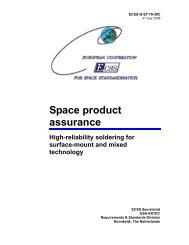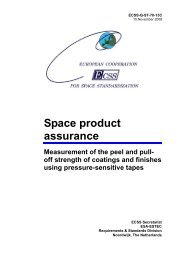ECSS-Q-70-03A (7 April 2006)
ECSS-Q-70-03A (7 April 2006)
ECSS-Q-70-03A (7 April 2006)
You also want an ePaper? Increase the reach of your titles
YUMPU automatically turns print PDFs into web optimized ePapers that Google loves.
<strong>ECSS</strong>-Q-<strong>70</strong>-<strong>03A</strong><br />
7 <strong>April</strong> <strong>2006</strong><br />
A.4 Surface preparation<br />
26<br />
d. Process procedures are described in detail in the following subclauses,<br />
while simplified processes are provided in Tables A-3 to Table A-6.<br />
e. The details of the type of hazard for each material used in the process are<br />
given in Table A-1.<br />
Table A-1: Chemical species used and associated hazard<br />
Item no. Description Type of hazard<br />
1 Trichloro-ethylene Harmful<br />
2 Trisodium phosphate,<br />
Na3PO412H20<br />
Harmful<br />
3 Sodium carbonate, Na2CO3 Harmful<br />
4 Nitric acid, HNO3 Corrosive, oxidizing<br />
5 Sulphuric acid, H2SO4 Corrosive<br />
6 Deionized water -<br />
7 Cobalt acetate (reagent grade) -<br />
8 Ammonium hydrosulphide<br />
(reagent grade)<br />
Corrosive<br />
9 Nickel acetate (reagent grade) Harmful<br />
10 Boric acid -<br />
Harmful: Substances can have limited effects on health and should not<br />
be inhaled, swallowed or absorbed through the skin.<br />
Corrosive: Substances can destroy living tissue and contact with the<br />
skin shall be avoided.<br />
Oxidizing: Substances produce highly exothermic reactions in contact<br />
with other substances, especially flammable or combustible<br />
materials. Separation from other hazardous substances and<br />
use in no-smoking zones should be observed.<br />
NOTE Other chemical products can be used instead of<br />
those indicated, e.g. sodium hydrosulphite instead of<br />
ammonium hydrosulphide.<br />
a. Before anodizing, all parts shall be cleaned in the sequence given. These<br />
treatments shall immediately precede anodizing:<br />
1. Vapour degreasing in trichloro-ethylene for 30 minutes.<br />
2. Etching shall be carried out in a solution of:<br />
Trisodium phosphate Na3PO412H20 12,5 g/l<br />
Sodium carbonate Na2CO3 6,2 g/l<br />
The temperature of the solution should be held at (93 ± 2) °C with a<br />
part-immersion time of 5 minutes.<br />
3. Rinsing with water.<br />
4. Desoxidizing for 3 minutes at room temperature in a 50 volume percent<br />
solution of nitric acid in water.<br />
5. Rinsing with water.<br />
6. Removal of all residues before anodizing by scrubbing or ultrasonic<br />
cleaning.<br />
7. Visual inspection of the workpiece shall be performed to check the<br />
absence of residues or particles. If residues or particles are found, a
















